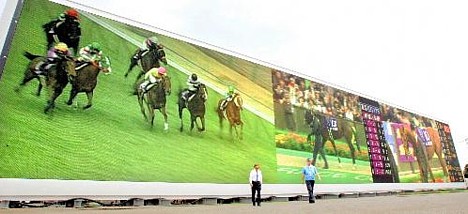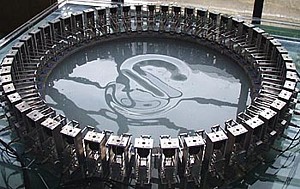 In squid-crazy Hakodate, squid fishing is big business, the local specialties include shio ramen (squid-topped ramen) and ikasomen (raw squid cut into the shape of somen noodles), the summer festivals have residents busting squid-like moves in a dance called ika-odori (a squirmy version of the traditional bon dance performed at summer festivals throughout Japan), and the city fish is the squid. It is therefore unlikely that anyone was surprised when, on July 18, a group of Hakodate residents made an official announcement regarding plans to create a giant robotic squid for the city.
In squid-crazy Hakodate, squid fishing is big business, the local specialties include shio ramen (squid-topped ramen) and ikasomen (raw squid cut into the shape of somen noodles), the summer festivals have residents busting squid-like moves in a dance called ika-odori (a squirmy version of the traditional bon dance performed at summer festivals throughout Japan), and the city fish is the squid. It is therefore unlikely that anyone was surprised when, on July 18, a group of Hakodate residents made an official announcement regarding plans to create a giant robotic squid for the city.
The citizens' group, called "Robot Festival in Hakodate," aims to create a new symbol for Hakodate, one of the leading tourist destinations in Hokkaido -- and what better symbol than a giant robotic version of the city's favorite creature?
Members of the group include university professors specializing in robotic engineering, who will work to incorporate cutting-edge technology that will allow the robot to be controlled remotely via the Internet. Development will be led by Hitoshi Matsubara and Hidekatsu Yanagi, information architecture professors at the School of System Information Science at Future University-Hakodate (FUN). Matsubara will handle the robotics research and development, while Yanagi will handle design. Students from the university, along with Hakodate high school teachers and students and others in the local manufacturing industry, will contribute ideas in brainstorming sessions.
The group has chosen "light" as the design theme for the robot -- a choice based on the night view from Mt. Hakodate, a popular local tourist attraction where visitors can marvel at the twinkling lights of the city and squid fishing boats offshore. In line with this theme, the entire body of squid robot will be covered in lights that blink as the robot moves. In addition, the robot will be equipped with a set of wireless receivers and will have its own homepage featuring a set of controls that allow remote users to move the robot's tentacles and eyes.
The developers plan for the robot to stand 5 meters (16 feet) in height. After an intial 1.5-meter prototype is completed this November, work will begin on the larger final version, which the group aims to unveil in a parade at the Hakodate Port Festival in the summer of 2007.
Masao Fujii, chairman of the citizens' group, says, "We hope to create a high-quality robot that attracts a lot of attention and makes people want to come to Hakodate."
The total cost of the robot is expected to be somewhere in the 30 million yen range (US$250,000). The group hopes to cover much of that cost with membership fees, so they are now recruiting members.
[Source: Hokkaido Shimbun]
 Seiko Epson has developed a paper-thin fingerprint sensor measuring 0.2 millimeter in thickness, which may help bring an extra level of security to a range of items in the future. When touched, the sensor reads fingerprint patterns based on the faint electric current emanating from the user's fingertip.
Seiko Epson has developed a paper-thin fingerprint sensor measuring 0.2 millimeter in thickness, which may help bring an extra level of security to a range of items in the future. When touched, the sensor reads fingerprint patterns based on the faint electric current emanating from the user's fingertip. 
 A mutant tomato with a face resembling a Chinese lion mask was harvested from a field in the city of Yahata in Kyoto prefecture. The common momotaro tomato is 3 times the normal size, measuring 10 cm in diameter and weighing 150 grams.
A mutant tomato with a face resembling a Chinese lion mask was harvested from a field in the city of Yahata in Kyoto prefecture. The common momotaro tomato is 3 times the normal size, measuring 10 cm in diameter and weighing 150 grams. 

 Researchers at
Researchers at  There is a mailbox located underwater off the coast of Susami in Wakayama prefecture.
There is a mailbox located underwater off the coast of Susami in Wakayama prefecture. 

 In squid-crazy Hakodate, squid fishing is big business, the local specialties include shio ramen (squid-topped ramen) and ikasomen (raw squid cut into the shape of somen noodles), the summer festivals have residents busting squid-like moves in a dance called ika-odori (a squirmy version of the traditional bon dance performed at summer festivals throughout Japan), and the city fish is the squid. It is therefore unlikely that anyone was surprised when, on July 18, a group of Hakodate residents made an official announcement regarding plans to create a giant robotic squid for the city.
In squid-crazy Hakodate, squid fishing is big business, the local specialties include shio ramen (squid-topped ramen) and ikasomen (raw squid cut into the shape of somen noodles), the summer festivals have residents busting squid-like moves in a dance called ika-odori (a squirmy version of the traditional bon dance performed at summer festivals throughout Japan), and the city fish is the squid. It is therefore unlikely that anyone was surprised when, on July 18, a group of Hakodate residents made an official announcement regarding plans to create a giant robotic squid for the city.